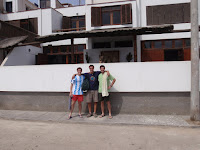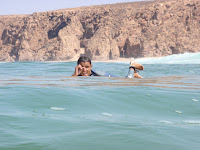I’ve been experiencing the ocean in way that I is new to me- on a board, riding waves for hours on end. I’ve taken up surfing and am loving it. No. I am in love with it. Surfing is an amazing way to experience the ocean because, thanks to a wetsuit, I can spend hours in the water without getting cold. There is also an extreme sense of connection with the all powerful and please yes I do respect you Goddess Ocean. It is a connection forged every time I enter the water for a surfing session, every moment that I pass under a wave, ride down the face of one, get destroyed by a wave but come up through the frothy surface alive and with salty water embedded into my eyes and nostrils. There is also the more tranquil and peaceful connection that is made during the times of repose as the serie of waves has passed, the ocean rests in a lull, and there is time to sit atop the surface of the water and absorb. Holy beautiful Pacific Ocean.

The fishing fleet in Pimentel, Northern Peru. And we swam around that pier, twice, with these lifeguards that you see below. It was actually a crazy swim, dodging fishing nets and swimming against a really strong lateral current.

The birds. Carlos and I were told by the Limenan lifeguards we’ve been working with that every time a flock of pelicans is seen soaring over the ocean towards the horizon, a large set of waves is soon to arrive. They shared this information with us during one of the training days for the soon to be lifeguards, and as sure as the pelicans did fly, a huge set of waves came rolling through. Now, after learning this, during the moments of lull I look for the pelicans and when they fly, begin to wait for the waves.
The only problem with the pelican theory is that with so many pelicans on the Peruvian coastline, it is hard to believe that every time a group of them flies overhead, a set of waves is on its way. This is especially true at Puerto Viejo, the beach that is 70km south of Lima and which I have come to love for its excellent left break and amazing marine and avian life. An off shore rock that serves as a pelican colony creates an abundance of these huge flying animals. The consistent surf of the Peruvian coast, however, seems to coincide with the bounds of pelicans, and so whether or not there is a direct connection between set frequency and pelican flight is hard to determine, but the relationship is strong enough that if you want to believe in it you can. And I choose to believe.
Inca Terns flying over sweet Pacific waves
Aside from pelicans, there are seabirds of all types, and I always wish that my Biology professor friends were here to enjoy in their flight and to help me better understand their lives. The Inca Tern is especially beautiful, garnered by an elegant white moustache that is underlined by brilliant yellow bands. It has a deep orange bill that matches its legs and a call that is reminiscent of a cat: miew miew. There is also a colony of these Inca Terns at Puerto Viejo. They seem to be very squeamish, and take flight as an enormous flock at the slightest disturbance, flying so low to the waters surface that I have splashed them as I waited in the water on my board for the next wave.
Gulls have never before appeared as beautiful as they do in Peru. I’ve been used to the Cheeto-eating type of Los Angeles that are often adorned by remnants of coloured pieces of plastic and hover in the sky vengefully awaiting to attack at the moment you leave your lunch on your towel for a quick dip in the sea. These Peruvian gulls, however, are brilliant. They seem so big and strong and have a white plumage that radiates the pacific sun. Their apparent health must be a product of their abundant grub. These birds eat well! Walking along the sea-shore at low tide you encounter a field of food: sand crabs, sea urchins, sea anemone, starfish, crabs, sea cucumber. If you like strong smells, then this banquet also smells amazing.
Another example of the abundant marine life is how I often have to dig through sand crabs to find the sand. There are layers upon layers of those critters and I am often reminded of how I used to spend hours and days hunting for them within the wet sand of the southern Californian Pacific, Santa Monica to be exact. These days in Peru, however, the hunt is easier and I enjoy reaching beneath the murky nutrient rich water to grab a handful of these small gray sand crabs, feeling the sensation of hundreds of little legs running around the palm of my hand, and than throwing the handful into the ocean around. Yes.
The Peruvian coastline is impressing me more than I could have ever imagined. The marine diversity, the waves, the water, the water the waves, and the yes.
















































